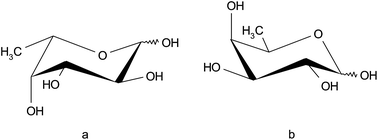Determination of l- and d-fucose using amperometric electrodes based on diamond paste†
Abstract
Monocrystalline diamond (natural diamond, synthetic-1 and synthetic-2) based electrochemical electrodes were designed for the analysis of L- and

* Corresponding authors
a
Laboratory of Electrochemistry and PATLAB Bucharest, National Institute of Research for Electrochemistry and Condensed Matter, 202 Splaiul Independentei Str., Bucharest, Romania
E-mail:
iustinavanstaden@yahoo.com
Fax: +4021 3163113
Tel: +40751507779
b Department of Chemistry, Al-Aqsa University, Gaza, Palestine
c Pharmaceutical and Medicinal Chemistry Department, The Pharmaceutical and Drug Industries Research Division, National Research Centre, Dooki, Cairo, Egypt
Monocrystalline diamond (natural diamond, synthetic-1 and synthetic-2) based electrochemical electrodes were designed for the analysis of L- and

 Please wait while we load your content...
Something went wrong. Try again?
Please wait while we load your content...
Something went wrong. Try again?
R. Stefan-van Staden, R. M. Nejem, J. F. van Staden and H. Y. Aboul-Enein, Analyst, 2012, 137, 903 DOI: 10.1039/C2AN15892B
To request permission to reproduce material from this article, please go to the Copyright Clearance Center request page.
If you are an author contributing to an RSC publication, you do not need to request permission provided correct acknowledgement is given.
If you are the author of this article, you do not need to request permission to reproduce figures and diagrams provided correct acknowledgement is given. If you want to reproduce the whole article in a third-party publication (excluding your thesis/dissertation for which permission is not required) please go to the Copyright Clearance Center request page.
Read more about how to correctly acknowledge RSC content.
 Fetching data from CrossRef.
Fetching data from CrossRef.
This may take some time to load.
Loading related content
